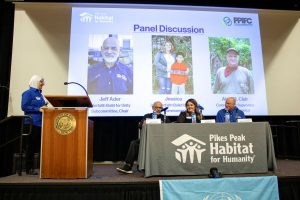On Sunday, Feb. 2, Pikes Peak Habitat for Humanity hosted our 4th interfaith dialogue, “United We Build: Together Building Homes, Building Lives,” in collaboration with the Pikes Peak Inter Faith Coalition (PPIFC) and Faith Table/ Together Colorado. The dialogue,...
Interfaith
4th Interfaith Dialogue Focuses on Unity: Part 1
Feb 6, 2025 | Interfaith, News & Events
On Sunday, Feb. 2, Pikes Peak Habitat for Humanity hosted our 4th interfaith dialogue, “United We Build: Together Building Homes, Building Lives,” in collaboration with the Pikes Peak Inter Faith Coalition (PPIFC) and Together Colorado. The dialogue, part of our...
4th Interfaith Dialogue: United We Build
Feb 3, 2025 | Interfaith, News & Events
Together Building Homes, Building Lives On Sunday, Feb. 2, we celebrated U.N. World Interfaith Harmony Week with our 4th interfaith dialogue at Berger Hall on the UCCS campus. Participants from young adults to seniors joined us for a meaningful...
Interfaith Takes Center Stage: An Interview with Sandra Walking Eagle
Jan 24, 2025 | Interfaith, News & Events
February ushers in U.N. World Interfaith Harmony Week, an annual celebration of interfaith projects and cooperation by people of goodwill. During this week, Pikes Peak Habitat for Humanity is holding our 4th interfaith dialogue, “United We Build: Together Building...
Amanda’s Family Story
Nov 5, 2024 | Homebuyer Spotlight, Interfaith
A Safe, Stable Home to Create Family Memories Amanda loves public speaking—and she has an incredible story to tell. Homeless at age 14, she has honed her professional skills and built a career. She’s sober. And she has regained custody of her three children, who were...
Companies Donate Roofs to Faith Builds
Oct 18, 2024 | Interfaith, Volunteers
Local roofing companies donated roofs to faith builds.






